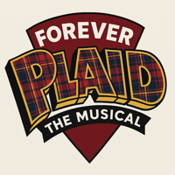
Overview
Synopsis
Forever Plaid is a lighthearted jukebox musical that celebrates the golden age of close-harmony “guy groups” of the 1950s. The story follows four earnest young men—Sparky, Jinx, Smudge, and Francis—who dreamed of becoming a popular quartet. Just as they were on their way to their first big break, tragedy struck when their car was hit by a bus filled with Catholic schoolgirls on their way to see The Beatles on The Ed Sullivan Show. Suddenly, the group finds themselves in a metaphysical limbo between life and afterlife. Granted one miraculous opportunity to return to earth, the Plaids seize the chance to perform the show they never got to deliver.
With charming banter, playful comedy, and boyish sincerity, the quartet performs beloved hits from the era, including “Three Coins in the Fountain,” “Catch a Falling Star,” and “Love Is a Many-Splendored Thing.” As they sing and reminisce, the Plaids reveal their quirks, insecurities, and deep camaraderie, endearing themselves to the audience. Each number becomes both a celebration of classic American pop and a step toward closure for the group. Ultimately, the show is a heartfelt and humorous tribute to friendship, nostalgia, and the power of harmony, as the Plaids finally fulfill their dream before saying a poignant goodbye.
Show Information
Context
When Forever Plaid premiered in 1989, it tapped into a deep sense of nostalgia for the music and culture of 1950s America. Written and originally directed by Stuart Ross, with musical arrangements by James Raitt, the show became a sleeper hit Off-Broadway, delighting audiences with its mix of comedy, harmony, and heart. At a time when jukebox musicals were not yet a mainstream phenomenon, Forever Plaid stood out for its affectionate tribute to a simpler era of pop music—an era defined by
to read the context for Forever Plaid and to unlock other amazing theatre resources!Plot
Act I
Scene 1 – The Arrival The stage is bathed in heavenly light as four young men—Francis, Jinx, Smudge, and Sparky—descend from the afterlife. They explain that they once formed a harmony group called The Plaids, but their dream ended tragically when a car accident cut short their first big break. Granted a miraculous opportunity, they return to earth for one night to finally perform the concert they always imagined.
Scene 2 – The First Songs The Plaids begin with romantic
to read the plot for Forever Plaid and to unlock other amazing theatre resources!Characters
| Name | Part Size | Gender | Vocal Part |
|---|---|---|---|
|
Lead |
Male |
Bass |
|
|
Lead |
Male |
Tenor |
|
|
Lead |
Male |
Tenor |
|
|
Lead |
Male |
Baritone |
Songs
Act I
Act II
A song with an asterisk (*) before the title indicates a dance number.
Monologues
Scenes
Key Terms
Close harmony is a vocal style in which multiple singers perform notes that are very near to each other in pitch, creating a tight, blended sound. This technique produces a warm, unified tone that emphasizes balance and teamwork between voices. It is commonly heard in barbershop quartets, doo-wop groups, and 1950s pop ensembles like the fictional Plaids.
A group of performers who function as a unit in a production rather than as individuals with leading roles.
A vocal register that allows singers to reach notes higher than their normal range, used for special effects or characterizations.
Farce is a comedic style that emphasizes exaggerated situations, improbable coincidences, mistaken identities, and rapid pacing. It often includes physical humor such as slamming doors, frantic chases, or characters hiding in plain sight. Farce is designed to generate nonstop laughter, often prioritizing chaos and absurdity over realistic storytelling.
A performance technique in which dialogue and action are created spontaneously. This term plays a vital role in understanding theatrical structure and is commonly encountered in stagecraft or performance settings.
A jukebox musical is a type of musical where the score is made up of pre-existing, well-known popular songs instead of original music.
Rapid and rhythmic speech or singing, often used in comic opera roles or musical theatre for humorous effect.
A form of theatre with a series of short sketches, songs, and dances, often satirical and lacking a unified narrative.
A running gag is a comedic device where a particular joke, situation, or character trait is repeated several times throughout a performance. Each recurrence builds familiarity, so the humor often increases as the audience begins to anticipate the repetition. For example, a character might always trip when entering a room or constantly forget names, creating laughter through expectation and variation.
Slapstick is a type of physical comedy that relies on exaggerated actions, pratfalls, and humorous accidents to provoke laughter. It often includes broad movements, funny sound effects, and comic violence, such as someone slipping on a banana peel or being hit with a harmless object. The style originated in commedia dell’arte and became popular in vaudeville, silent film, and stage comedy.
Videos
Quizzes
Themes, Symbols & Motifs
Themes
Nostalgia & Memory The show celebrates
to read about the themes, symbols and motifs from Forever Plaid and to unlock other amazing theatre resources!Quote Analysis
Sorry! We do not currently have learning modules for this guide.

